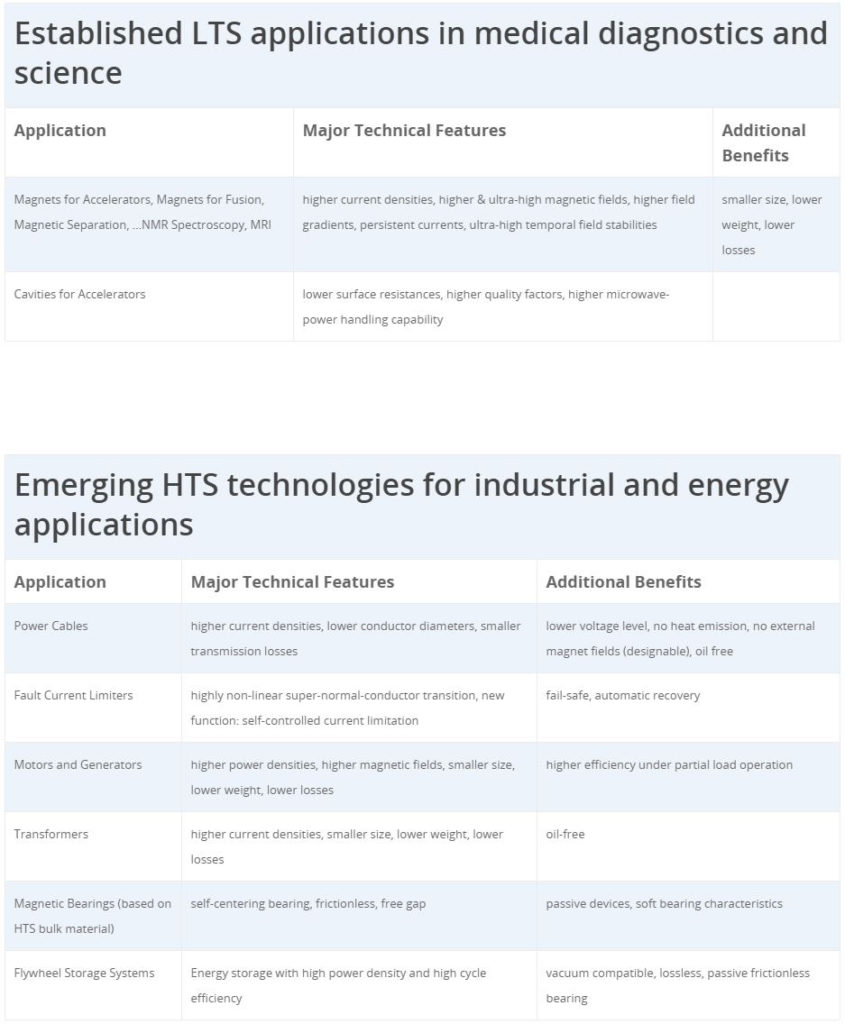Superconductivity is a unique natural phenomenon and the superconducting state shows a number of extraordinary features:
- zero electric DC resistance
- extremely high current density
- sharp transition into resistive regime
- expulsion of magnetic fields
- magnetic field penetration and flux pinning
It allows, for example, a DC current to flow with no loss. Today strong superconducting magnets, exploiting this zero DC resistance, are routinely used in medical diagnosis, science, research and technological development (RTD). Magnetic Resonance Imaging (MRI), a standard diagnostic system routinely used world-wide, represents the biggest current market for superconductivity. The very high current densities and the ultralow losses of superconductors will also result in large energy and material resources saving power applications. Successful large scale demonstrations of power cables, motors and generators, or fault current limiters (new, innovative devices for power grids), have already been made. All in all, superconductors enable smaller, lighter and more efficient devices, sometimes even with new functions, which cannot be realized with classical conductors like copper.
Still another application is in ultrafast, ultralow-power superconductor electronics or in exceedingly sharp, low noise microwave filters for base stations of radio communication systems. Finally, „Superconducting Quantum Interference Devices“ (SQUIDs) based on weakly coupled so-called Josephson Junctions, enable to monitor magnetic fields, which are more than a billion times weaker than the earth magnetic field. They made it e.g. possible to successfully record functions of the heart and the brain. Such applications are also expected to play an important role in the future but are not any further referred to here, as we currently have no active members in Europe in such fields.
Superconductivity has been found in 1911 and is considered as one of the major discoveries of the 20th century. Most materials exhibit superconductivity at very low temperatures but only a few of them at temperature high enough to be considered as practical superconductors. The classical superconductors (metals, alloys) have critical temperature in the range of 4 K to 23 K and are referred to as Low Temperature Superconductors (LTS) typically cooled with liquid helium (LHe, at 4 K).
In 1986 superconductivity was discovered in a new class of ceramic materials, cuprate perovskites, with significantly higher transition temperatures beyond 77 K, which are referred to as High Temperature Superconductors (HTS) because liquid nitrogen (LN2, at 77 K) can be used as a coolant.
Now, more than a century after the first discovery of the phenomenon and more than a quarter century of the discovery of HTS, the full commercial potential of superconductivity is just beginning to be exploited, forming the basis for new commercial products that are entering our economy and daily life.

In summary, there is a number of components and systems in the different fields of electric power, industrial processing, transportation, medical applications as well as information and communication, in which superconductors offer superior and unique functions. Further information about the current status of the different applications is presented under Technology.
Even after the advent of the HTS, which are considered as a major break-through due to the much less expensive and less complex cooling needed, the discovery of novel superconductors continues. A superconductor which in several respects is somewhere between LTS and HTS is magnesium di-boride, MgB2, that was discovered in 2001.
Another class, an iron based family of superconductors, also referred to as pnictides, e.g. LaO1-x Fx FeAs, which have slightly higher transition temperatures than MgB2, came up in 2008.

